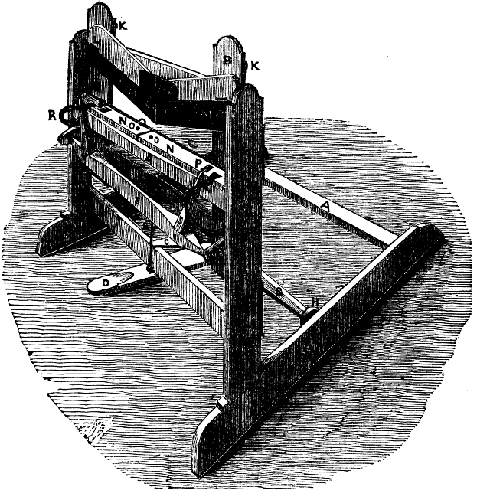Daniel Drawbaugh was a mechanic and a talented and versatile inventor who never achieved any particular commercial success. Starting in the 1840s he invented an automatic sawing machine, wagon-making machinery, a spoke-tenoning machine, and a stave jointer. The stave jointer was patented in 1851, and was "pretty generally introduced, and its merits appreciated." He next designed and patented a jointer-knife grinding machine, millstone mounting, millstone manufacturing process, nail-making machines, molasses faucet, water pump for fire engines, a motor that ran on water pressure from a hydrant, a wire braiding machine, several pneumatic tools for rock cutting, pasteboard boxes, and a battery. His last invention was granted in 1903, which means that he was an active inventor for over fifty years.

Drawbaugh's stave jointing machine, patented 1851.
Drawbaugh would be almost completely forgotten now but for his role in a notorious patent lawsuit that went to the U. S. Supreme Court in 1888. Some years after Alexander Graham Bell had received his 1876 telephone patent, Drawbaugh claimed that he had invented the telephone before Bell. The People's Telephone Co. used Drawbaugh's claims to try and defeat the Bell Telephone Co.'s patent monopoly. In a 9-3 decision, Drawbaugh's claims were rejected and the Bell patent was upheld. Drawbaugh did receive an 1884 patent for a telephone transmitter.
Information Sources
- Article in the 1851-12-27 issue of Scientific American, describing Drawbaugh's recently patented stave jointing machine.
- Listed in Kenneth Cope's American Cooperage Machinery and Tools. Cope's writeup is based on the Scientific American article mentioned above.
- Brief writeup in the 1852-05-29 issue of Scientific American on Drawbaugh's stave cutter, for which he had applied for a patent. It appears that such a patent was never granted.
- Brief writeup in the 1854-04-01 issue of Scientific American on Drawbaugh's improved stave machine, on which a patent issued on 1855-05-22.
- The 1867-10-26 issue of Scientific American describes a new rotary water pump that was based on Drawbaugh's 1866-11-20 patent for a molasses faucet. "For particular respecting sale of territory, or orders for pumps, address Wm. R. Gorgas, Treasurer Drawbaugh Pump Co., Eberly's Mills, Cumberland, Co., Pa., or David Stevenson, Jr., Manufacturer, Harrisburg, Pa."
- The 1874 work, Wiley's Wiley's American iron trade manual of the leading iron industries of the United States lists D. Drawbaugh of "Eberley's Mills" as a machinery maker.
- An article in the September 1888 issue of The Atlantic Monthly discusses the recent Supreme Court decision rejecting Drawbaugh's claim to have invented the telephone before Alexander Graham Bell. Drawbaugh did not establish the date of invention, relying on the testimony of others who had heard Drawbaugh's demonstrations of his new device. That testimony was judged unreliable, based on certain inconsistencies in the testimony taken as a whole. In addition, Drawbaugh had reproduced his instruments but they worked poorly, which undermined testimony that his invention had worked perfectly. Finally, Drawbaugh had failed to immediately attempt to patent his invention, and since the invention of the telephone was a widely anticipated (and potentially lucrative) event, the Court decided that it was more likely that Drawbaugh had invented the story rather than the telephone.
- An article by Olive Thanet in the February 1892 issue of Scribner's magazine discusses the Supreme Court case, from 1887, of Bell Telephone Co. versus The People's Telephone Co. The main point of contention was whether Daniel Drawbaugh had an electric telephone in operation prior to 1876 when Mr. Bell received his patent. Six hundred witnesses testified for one side or the other. Three of the Justices were persuaded that Drawbaugh had indeed invented the telephone before Bell, but the rest were not convinced. The article is, ultimately, a discussion of the fallibility of memory.
- An article in the June 1893 issue of Manufacturer & Builder reports that Commisioner of Patents William E. Simonds had allowed Bell Telephone Co. to make copies of Drawbaugh's telephone patent applications, when he had denied permission to other people to copy other applications. This was a gray area in the law but the article argues that universal expectation was that applications were confidential.